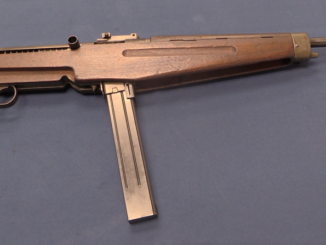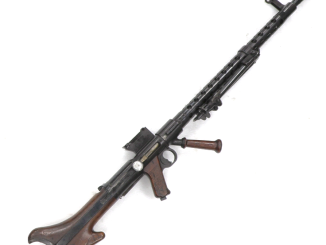I’ve been meaning to put this video together for a while, and finally have it – a detailed look at the mechanics and internal workings of the Frommer 1910. This was the third major iteration of Rudolf Frommer’s long-recoil locked-breech pistol design, and the most successful up to it’s time (although that isn’t saying much; fewer than 10,000 were made). It would hold that place for only two years before the 1912 Frommer Stop went into production and proved much more popular.
The 1910 model suffered from a number of problems that kept it from ever achieving real commercial success. It used a pretty wimpy cartridge, even by the standard of 1910. It was 7.65x13mm cartridge that pushed a 71gr bullet at about 820fps – roughly 80% the velocity of a the .32ACP. It was not a particularly ergonomic pistol, and it was far more complex than necessary for its cartridge, thanks to its rotating bolt and long recoil action. Of course, characteristics that made it a commercial disappointment also make it a pretty interesting gun to look at today:
I have a bit more information in the Vault regarding the other Frommer pistols (1901, 1906, and Stop), and Ed Buffaloe also has an excellent article on them.




…and the winner of the Rube Goldberg weapon design is….see above
http://en.wikipedia.org/wiki/Rube_Goldberg_machine
“Heath Robinson” idea’s, are what keeps the world turning!
Was that early 7.65mm Frommer round more heavily loaded than the black powder type pressure levels of the Browning rounds?
http://www.cruffler.com/historic-august00.html
states that: “This [7,65mm Frommer] is the same cartridge as the 7.65mm Roth Sauer, dimensionally similar to a .32 ACP with a shorter cartridge case.”
The en.wikipedia’s article “7.65mm Roth-Sauer” say “Two self-loading pocket pistols were designed for this cartridge. One was manufactured by Roth-Sauer of Germany, and the other by Frommer of Hungary.” citing Wilson’s Textbook of Automatic Pistols. The mentioned “Roth-Sauer” is a Roth-Sauer pocket pistol (similar to but smaller than Roth-Krnka M.7 Austrian service pistol). В.Е. Маркевич refers to this pistol as Roth-Sauer Model 1904 automatic pistol and states that only trial batch was produced and that this is pistol uses 7,65mm Browning (i.e. .32 Auto) ammunition. Production was stopped due to complexity of design and problems with ammo loading (this pistol used plastic stripper clips).
Note: I think that owners don’t trust in blow-back principle – “If the slide is not locked wouldn’t firearm throw bolt in my eye?”
The complicated mechanism of this firearm can be easily explained – Frommer Model 1901
http://www.hungariae.com/From01.htm
(the firearm from which Model 1910 is derived) was built for 8mm Roth-Steyr (cartridge for Krnka M.7 pistol) which is far more powerful than Model 1910’s cartridge. What is interesting:
“In 1903 at the Swedish military pistol trials the 9mm Frommer M1901 outperformed its competitors in most categories, but it was rejected in favour of the Browning only because the Frommer did not have a removable magazine.”
Note that civilian owners in Europe in early 20 century had fondness for little cartridge – for example see 4.25mm Liliput – it has .168″ bullet i.e. smaller than modern BB guns (.177″) at MV = 250m/s or 810fps – i.e. less than .32ACP or .380 Auto.
As a early ’90s (1991 I think, so 12 y/o), grandfather took me to visit one of his friends where I fired my first shot from the gun – this one. It missed mag and was reworked to .32 ACP, so you had to load a single cartridge at time. I asked what kind of gun was that and answer was “some Hungarian, that I took in partisans”).
I remember that i could barely operate grip safety, but I did hit a target (at 5m or so, but still for a first time 🙂 )…
Wonder what happened to that gun…
Great video, as always. I have been waiting for you to feature one of Frommers works for a long time 😀
You mentioned the french Chauchat in the video, and I heard that its design was based on one of Frommers early 1908 patent.
http://kepfeltoltes.hu/view/140203/nhgalXf1X6m_www.kepfeltoltes.hu_.jpg
I’m not entirely sure about that, but i think it’s a possibility regarding Frommers fondness towards the long recoil system.
I also have some pictures about a Chauchat-like machine gun presented to the troops by Rudolf Frommer (he is the gentleman in white),
http://kepfeltoltes.hu/view/140203/nhgalzrIOsZ_www.kepfeltoltes.hu_.jpg
and a soldier using it.
http://kepfeltoltes.hu/view/140203/nhgal0fh5ib_www.kepfeltoltes.hu_.jpg
I unfortunately don’t know anything else about this gun (designation, caiber, production volume) nor the date of when the pictures were taken (maybe someone who knows about the military uniforms ofthat era could tell), so if any of you could provide me some information about the gun, that would be greatly appreciated.
I have also found some pictures of a modified Frommer Stop from 1912 with a 20 round magazine and a capability of full auto fire, called the 17M “Assault Pistol”
http://ah.milua.org/wp-content/uploads/2010/08/Frommer_MP_Stop.jpg
It has no trigger and trigger guard, and two of those were fixed on a Villar Perosa-like tripod/mount.(The 17M predates the VP)
http://ah.milua.org/wp-content/uploads/2010/08/Frommer_MP.jpg
It doesn’t look very practical, but it just looks soo cool 😀
I find it interesting that FEG (aka Hungarians, originally within Empire and later on their own) had such interest in independent small arms manufacture.
They may not have gathered as much glory as perhaps CZ did, but however I hold them in high respect.
The model which followed after this was lot better in every measurable way. The operating system is cute and thoughtful.
I went in past into page Daweo is showing and I intended to do just that, but he was quicker. Thanks for that and for video!
Long-recoil system is for me unnecessary for cartridges like 7.65mm Frommer (.32 ACP hot-loaded) or .380 Auto. I think that this system is useful for powerful cartridges (note: Gabbett-Fairfax Mars is long-recoil firearm) but nowadays forgotten in this role in favor for gas-operated principle (Wildey Magnum, Desert Eagle and other big-bore automatic pistols).
That’s right Daweo. Now, isn’t gas operated kind of silly for pistol? Long recoil operated system would make sense to me since there is chance to attenuate some of the energy on the way. Also and mainly, it would not give kick immediately at trigger release.
I see the long-recoil advantage over the gas-operated firearms in fact that long-recoil firearm can adjust itself for the powder charge – see the Browning Auto-5 shotgun:
http://world.guns.ru/shotgun/be/browning-auto-5-e.html
It worked properly despite the very different powder charges of 1890s shotgun rounds. So far I don’t know about self-adjusting gas-operated firearm, most gas-operated can be adjusted manually but did anyone hear about selfadjusting gas-operated firearm?
You have got that right!
Now, if you were, for argument’s sake, to think about a pistol along this line, you need to address the fact the barrel must pass over the top of magazine and it has to clear the top of it. For doing so, it may require a relief to bottom portion, which may make it weaker (especially in chamber area). Another take would be to let mag pop down a bit and come back again. What is your view of that potential problem?
Sadly, I’m not aware of any long-recoil pistol excluding Gabbett-Fairfax Mars which has quite overcomplicated feeding system and Frommers which use quite weak cartridges, but still I can get some examples of long-recoil operated long-arms. In this case the Remington Model 81 Woodsmaster, this long-recoil operated firearms uses box-magazine (best suited for automatic pistol) and so far I know don’t have feeding reliability or strength issues. Now the question is: “If it will be scaled down will it works reliable?”.
Moreover, remember that modern metallurgy far more advanced that this of early 20 century i.e. problems that can’t be overcome in 1900s now can be.
And additional question: you want simple big-bore pistol or big-bore high-pressure pistol?
Fair answer, thanks!
BTW, I looked at current status of FEG and it says – bankrupt. Their last product was 9mm pistol aka FN Grand puissance. They say it was actually so close that some parts were interchangeable. I believe that one Chinese company took on that project lately.
FEG went under in 2006 in no small part due to corrupt maneuvering of politicians and their closely aligned business partners, coupled with inept and archaic company management that just refused to understand that it was not 1960 anymore.
Their last products were variations of the PA-63 in different configurations and calibers, P9RC pistols that are used by the police and armed forces as the 96M service pistol and P9M-s which are copies of the FN High Power. The initial version of the latter was 100% parts interchangeable with the High Power, later versions had different safety catches and slide releases.
It is a shame really, I believe Hungary is the only country in the region that does not have any small arms manufacturing capability apart from small private ventures. But at least when current stocks of AK-63-s, AMD-65-s, PA-63-s and P9RC-s run out, the corrupt oligarchs running this country will have a chance to purchase some foreign equipment for 10x the market value, with the extra cash “mysteriously’ disappearing…
Thanks for insider’s view Tom.
The issues you mention plague to some degree all ex-com nations. Similarly, with degree of dismay I watched exit of another Hungarian brand – Pannonia motorcycles. Sad picture, isn’t it.
Interesting points with this pistols (excepting being provided an extra powerfull
lock system for a weak round), are;
– There is no disconnector. Trigger and sear connection is escaping type or one
time interrupter. Pistol has a risk of battery off firing.
– Magazine to barrel feeding is on “Push Feed” type. Extractor locates on its
groove on the case when fully chambered. No need to wory for extractor breakage
when manualy single loaded.
– All moving parts have captive springs. No need to wory for lost springs.
Hungarian small arms up to middle of the last century were really exceptional, but
their later production were mostly based upon clones of well known brands and still
they are.
Yes, I also noticed lack of disconnector, but barrel catch seem to sub for it. As usual, quality observations on your part.
The lack of a positive type disconnector is also present on, upgraded “Stop” model.
which a downward lug onthe sear is pressing down the trigger bar out of engagement
when the hammer is uncocked. Again another one time interrupter.
If sum up, Frommer 1910 works like at following;
– At instant of firing, the barrel extention with locked breechbolt recoil back by
residual gas and gained momentum until the breechbolt striking against to the
post on which the back of breechboolt return spring rests and the firing pin
crosses through. The empty case is caught by extractor and forced to swing out of
the barrel by spring exerted ejector but can not since surrounded in the chamber.
Breechbolt stop rises and holds the breechbolt at back. There is no residual gas
remaining at end of that stage.
– Compressed return spring around the front section of barrel forces the barrel
extention forward as forcing the breechbolt lock to rotate out of engagement with
itself and when it reaches to a fore distance to eject the empty case, it is
thrown out of the pistol as the bottom lug of breechbolt waiting behind the top
cartridge in the magazine. The barrel extentinon reaches to the foremost position
and cams down the breechbolt stop as freeing it to run forward and drive the top
cartridge in the magazine out of lips as entering into the chamber but letting
the extractor to snap into the groove on the case after fully chambered by cause
of the case back rising and entering into the round hole cut on the breechbolt
front face. There should be a firing pin rebound spring wound around the front
section of firing pin, or in other case there should be a possibility to slam
fire the chambered round. When the brechbolt is on near end of forward running,
the rotating breechbolt forces to turn and lock into the barrel extention.
– The triger is on still taken back position, but its rear spring assisted moving
tip is thrown out of sear connection since the rearward prassure of trigger
finger forced to. When released, the rear tip swings upward and locates under the
sear front end as ready to another trigger actuating. If a human finger would be
fast to release and grasp the trigger before the breechbolt to go to its foremmost
position, it would be possible to drop the hammer, but its strike would remain
below the firing pin reach as not causing a discharge.
The construction on Ian’s video seems to me like so.
By the way. the similarity of breechbolt return spring and hammer construction
with sometime earlier Charola-Anitua pistol is interesting.
Nice.
I have a 1010 pistol, but newer dared to take it apart, now J qill have A try.
I belive it wasmade in some sort of 9 mm two
Case lengh 12,8 to13,1 mm